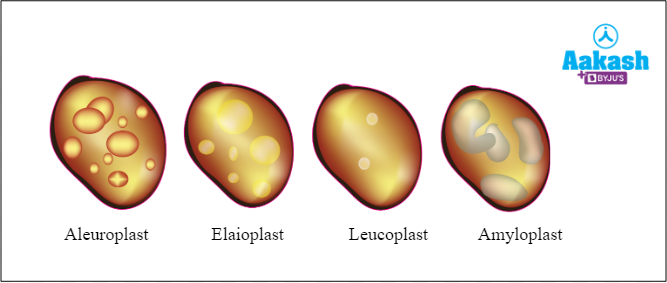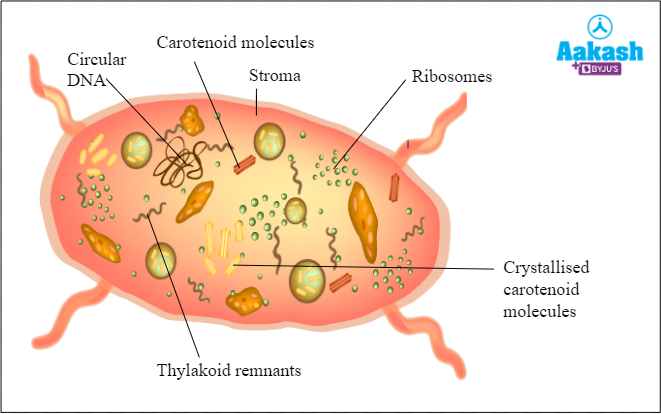-
Call Now
1800-102-2727
Plastids: Chloroplasts, Chromoplasts, Leucoplasts Comparison Between Mitochondria and Chloroplasts, Practice problems and FAQs
What is the biggest power that a plant has but we do not? It is the superpower of being able to prepare their own food within their body with the help of easily available ingredients such as carbon dioxide, water and sunlight. Do you know what gives this superpower to the plants? It’s their green colour! Sounds cool right? But what gives them this green colour? The secret lies within the cells of the plants which have a unique organelle that is lacking in animal cells.
In fact the bright and attractive colours of the fruits, flowers and vegetables is also a contribution of these organelles.
Let me bring to your notice another useful ability of plants to store prepared food in specific parts of their body such as roots, stems, etc. Did you know that the organelles that we had been talking about have an important role to play in this too? So what are these magic organelles that the plants have? These are known as the plastids and just as mitochondria, these too are considered as semi-autonomous organelles of eukaryotic cells. Why? Come, let’s try and understand as we learn more about these.
Table of contents
Plastids
Plastids are double membrane bound organelles found in the cytoplasm of plant cells and some protists such as Euglena. They possess their own genetic material, i.e, circular and naked DNA, protein synthesising machinery, i.e, ribosomes (70S) and can multiply on their own. Thus, plastids are considered to be semi autonomous in nature.
Depending on the type, plastids may or may not possess pigments.
Types
Plastids are of three different types - leucoplast, chloroplast and chromoplast. All the three forms of plastids develop from plastid precursors known as proplastids.

Fig: Types of plastids
Leucoplasts
These are colourless plastids. They are present in the non-green plant cells that are not exposed to sunlight. These may be round, oval, disc-shaped, cylindrical, rod-shaped or filamentous in shape. A leucoplast contains lamellae but the lamellae are not organised to form grana. Photosynthetic pigments are absent and leucoplasts are mostly specialised for storage of food. Leucoplasts are classified into three types based on their storage materials -
- Amyloplasts
Synthesise and store starch. Found in potato tubers, wheat and rice grains
- Elaioplasts
Store lipids and oils in fat droplets. Found in mustard, castor endosperm.
- Aleuroplasts
Store proteins. Found in brazil nuts, peanuts and pulses

Fig: Leucoplasts
Chromoplasts
The chromoplasts are coloured and occur in the cells of the red, yellow, orange coloured parts of the plant.They have fat-soluble carotenoid pigments like carotene and xanthophylls.which impart the colours to plant parts such as fruits, flowers, vegetables, etc. Chromoplasts develop from proplastids, leucoplasts or chloroplasts.
Chromoplasts have abundant lipid globules. Carotenoids occur both dissolved in lipid globules as well as in crystallised state.

Fig: Chromoplast
Apart from being rich in carotenoid pigments and imparting colour to plant parts, chromoplasts also help in lipid synthesis. Certain carotenoid pigments serve as precursors to Vitamin A as well as abscisic acid which is a growth regulator that helps to close stomata and induce dormancy in a plant.

Fig: Chromoplasts in fruits and flowers
Chloroplasts
Chloroplasts are the green coloured plastids which contain the green pigment chlorophyll in abundance. Needless to say these organelles are found in the cytoplasm of the cells of the green parts of plants and protists such as euglenoids. These organelles serve as the sites for photosynthesis as the chlorophyll is capable of absorbing light wavelengths that are required for photosynthesis to occur.

GIF: Inside a chloroplast
Chloroplasts can be lens-shaped, oval, spherical, discoid or even ribbon-like. Their length varies between 5-10μm and width ranges from 2-4μm. Their number can vary. Chlamydomonas, a green alga, has a single chloroplasts whereas each mesophyll cell has 20-40 chloroplasts.
Some of the various shapes of chloroplasts found in different types of cells are -
|
Chloroplast shape |
Organism |
Diagram |
|
Cup shaped |
Chlamydomonas |
Fig: Chloroplast in Chlamydomonas |
|
Oval |
Plant cells |
Fig: Chloroplast in plant cells |
|
Ribbon shaped |
Spirogyra |
Fig: Chloroplast in Spirogyra |
|
Stellate or star shaped |
Zygnema |
Fig: Chloroplast in Zygnema |
Its structure involves following parts
- Membranes
- Stroma
- Lamellae
Membranes
Enclosed in two membranes -outer and inner membranes of thickness 75-100 Å. Fluid-filled periplastidial space is present between two membranes which is 100-120 Å thick.
Stroma
It is the matrix or ground substance enclosed by the chloroplast membranes which is made up of colourless, granular and colloidal substances. It contains proteins, lipids,70S ribosomes,circular DNA,RNA ,enzymes and lipid droplets.
Lamellae
Lamellae are closed ,flattened sacs, also known as thylakoids. Thylakoids are packed in piles called ‘grana’.The thylakoids of adjacent grana are connected to each other by some membranous tubules called ‘stroma lamellae’. The thylakoid membranes possess chlorophyll a and b molecules, carotenoids, cytochromes b and f, quinonses, ATP-synthase enzymes, etc.

Fig: Structure of Chloroplast
Comparison between mitochondria and chloroplast
According to the endosymbiotic theory of the origin of chloroplasts and mitochondria, both are believed to be prokaryotic organisms which might have been engulfed by eukaryotic cells and have existed symbiotically ever since. Chloroplasts are believed to be autotrophic prokaryotes which might have been internalised by eukaryotic cells during the development of autotrophic eukaryotes and got incorporated within them as semi-autonomous organelles.
Differences between mitochondria and chloroplast
|
Mitochondria |
Chloroplast |
|
It is the powerhouse of the cell. It helps in energy production by cellular respiration. |
It is the site of photosynthesis in green plants. |
|
Involved in aerobic respiration..Found in plants, animals, fungi doing aerobic respiration. |
Present in unicellular and multicellular algae and green plants for performing photosynthesis |
|
Shaped like a bean |
Shaped like a disc |
|
Has no colour |
Green in colour |
|
In a mitochondrion, the main sites of reaction are cristae and the inner matrix. |
The main sites of reaction are stacks of thylakoid and a granular matrix called stroma. |
|
Utilises oxygen to release energy |
Utilises energy to produce oxygen and food. |
|
No pigment is present |
Pigments such as chlorophyll, carotenoids are present in it. |
|
Releases energy by breaking down organic food to carbon dioxide and water |
Traps solar energy and uses carbon dioxide and water to produce glucose |
Similarities between mitochondria and chloroplast
(i) Both are surrounded with a double membrane.
(ii) The inner membrane forms infoldings in both
(iii) Both are semi-autonomous. DNA is circular, double stranded and naked in both.
(iv) Both possess 70S ribosomes.
(v) Take part in energy transduction.
(vi) Both of them produce ATP.
Practice problems
1.You see so many differently colored flowers blooming on plants around you.similarly fruits are also found in bright colours. The colours of flowers and fruits are attractive to insects and animals which help in pollination and seed dispersal. These bright colours are due to the presence of
(a) Chromoplasts
(b) Chloroplasts
(c) Amyloplasts
(d) Leucoplasts
Solution: The chromoplasts are coloured and occur in the cells exposed to sunlight.They have fat-soluble carotenoid pigments like carotene and xanthophylls.which impart the colours - yellow, orange, and red.
Thus, the correct option is a.
2. Choose the correct option:
- Amyloplasts - stores protein
- Elaioplast - stores fat
- Aleuroplast - stores starch
- Leucoplast - contains photosynthetic pigments
Solution: Leucoplasts are colourless plastids which do not contain any pigment and are often specialised to store food. Amyloplasts store starch, elaioplasts store fats and oil droplets and aleuroplasts store proteins.
Thus, the correct option is b.
3. Extranuclear DNA is the DNA which is present outside the nucleus ,in some other cell organelle. It has similarities with bacterial DNA. Where can these type of DNAs be found in a cell?
(a) Ribosome
(b) Chloroplast and mitochondria
(c) Golgi apparatus
(d) endoplasmic reticulum
Solution: Chloroplast and mitochondria both are semi-autonomous, having a naked DNA which is circular and double stranded. These organelles also possess their own protein synthesising machinery in the form of RNA and 70S ribosomes.
Thus, the correct option is b.
4. Factory for synthesis of sugars in autotrophic eukaryotes is
(a) Mitochondria
(b) Chloroplast
(c) Ribosome
(d) Endoplasmic reticulum
Solution: Chloroplast is considered the factory for synthesis of sugars.They are the most common type of plastids that are directly involved in photosynthesis because they contain the chlorophyll pigment that traps the light energy required for photosynthesis and also contain all the necessary enzymes for carbon dioxide fixation and production of sugars and ATP.
Thus, the correct option is b.
FAQs
1. Why do fruits change colour during ripening?
Answer: During ripening of fruits, the green colour gradually fades due to the gradual degradation of chlorophyll containing lamellae in chloroplasts as they convert into chromoplasts and the carotenoid pigments become more prominent.
2. Why is chlorophyll green in colour?
Answer: Chlorophyll absorbs light in the red (660-760 nm) and blue (470 - 500 nm) region of the visible spectrum and reflects the green light. Thus, it appears green in colour.
3. What is the structure of a chlorophyll molecule?
Answer: Chlorophyll has a tadpole like structure with a porphyrin head and a phytol tail. The porphyrin head consists of four pyrrole rings connected to each other by methine ( -CH=) groups. Each pyrrole ring is composed of a skeleton of four carbons and one nitrogen atom with the nitrogen of each pyrrole ring towards the centre of the porphyrin head. At the centre of the porphyrin head lies a magnesium atom that is connected to the nitrogen atoms of the four pyrrole rings with the help of two covalent and two coordinate bonds.

Fig: Porphyrin head of chlorophyll
Fig: Porphyrin head of chlorophyll
4. What are the health benefits of chlorophyll in the human body?
Answer: Chlorophyll supplements are known to have multiple benefits for the body such as preventing cancer, healing wounds, treat scars and acne, help in weight loss, neutralise toxins, etc.







